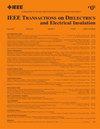Molecular Insights Into the Effects of Thermal Oxidative Aging on the Insulation Properties of Cross-Linked Polyethylene
IF 3.1
3区 工程技术
Q2 ENGINEERING, ELECTRICAL & ELECTRONIC
IEEE Transactions on Dielectrics and Electrical Insulation
Pub Date : 2025-02-19
DOI:10.1109/TDEI.2025.3543802
引用次数: 0
Abstract
The degradation of the insulation performance of cross-linked polyethylene (XLPE) during thermal oxidative aging is a crucial factor affecting the safe operation of cables. Investigating the influence of the structural degradation process of XLPE on its insulation properties from a molecular structure and microscopic parameter perspective can provide a better understanding of the molecular mechanisms behind insulation performance degradation during thermal oxidative aging. In this study, the reaction kinetics of XLPE were simulated using the Ab initio molecular dynamics (AIMDs), resulting in the extraction of five XLPE structures with varying degrees of aging. Density functional theory (DFT) simulations were employed to analyze the variation patterns and differences in discharge-related microscopic parameters of these five different XLPE structures under varying electric field intensities. The results show that there are significant differences in the structure and dipole moment of XLPE with different aging degrees, resulting in large changes in its microscopic parameters. In particular, the formation of carbonyl groups in XLPE has a significant impact on its structure and microscopic parameters. As the aging degree of XLPE increases, the ionization of XLPE molecules and the activity of electron affinity (EA) molecules intensify. The structural evolution of XLPE during the aging process markedly influences the excitation process and molecular orbitals of its molecules, facilitating the release of numerous photons, creating conditions for secondary electron collapse, and enhancing molecular conductivity. The simulation results of the molecular surface electrostatic potential (ESP) reveal that deeper aging of XLPE increases the likelihood of electrophilic and nucleophilic reactions, as well as electron accumulation and collision. Overall, the electric field exerts a minimal effect on the molecular structure and microscopic parameters of different XLPE molecules.热氧化老化对交联聚乙烯绝缘性能影响的分子研究
交联聚乙烯(XLPE)在热氧化老化过程中绝缘性能的下降是影响电缆安全运行的关键因素。从分子结构和微观参数的角度研究XLPE结构降解过程对其保温性能的影响,有助于更好地理解热氧化老化过程中保温性能降解的分子机制。本研究利用从头算分子动力学(AIMDs)模拟了XLPE的反应动力学,提取了5种不同老化程度的XLPE结构。采用密度泛函理论(DFT)模拟分析了不同电场强度下这5种不同XLPE结构放电相关微观参数的变化规律和差异。结果表明:不同时效程度的XLPE在结构和偶极矩上存在显著差异,导致其微观参数变化较大;特别是羰基的形成对XLPE的结构和微观参数有显著的影响。随着XLPE老化程度的增加,XLPE分子的电离和电子亲和(EA)分子的活性增强。老化过程中XLPE的结构演变显著影响了其分子的激发过程和分子轨道,促进了大量光子的释放,为二次电子坍缩创造了条件,增强了分子的电导率。分子表面静电势(ESP)的模拟结果表明,XLPE老化越深,发生亲电和亲核反应的可能性越大,电子积累和碰撞的可能性也越大。总的来说,电场对不同XLPE分子的分子结构和微观参数的影响很小。
本文章由计算机程序翻译,如有差异,请以英文原文为准。
求助全文
约1分钟内获得全文
求助全文
来源期刊
CiteScore
6.00
自引率
22.60%
发文量
309
审稿时长
5.2 months
期刊介绍:
Topics that are concerned with dielectric phenomena and measurements, with development and characterization of gaseous, vacuum, liquid and solid electrical insulating materials and systems; and with utilization of these materials in circuits and systems under condition of use.

 求助内容:
求助内容: 应助结果提醒方式:
应助结果提醒方式:


